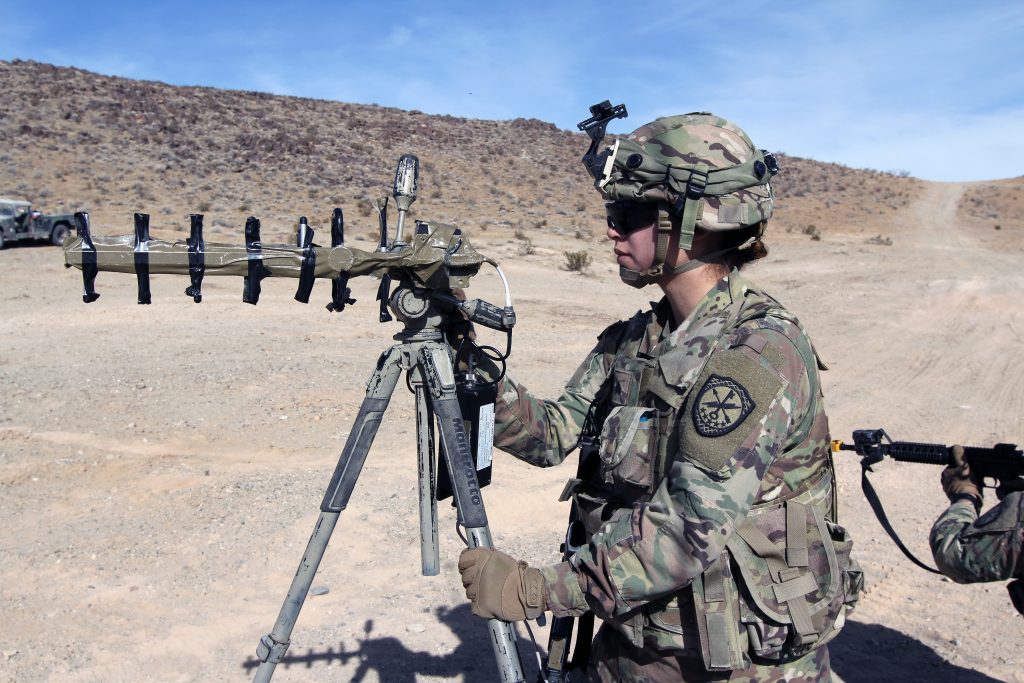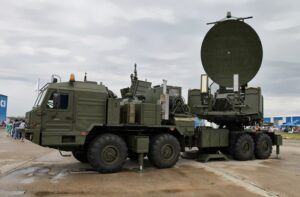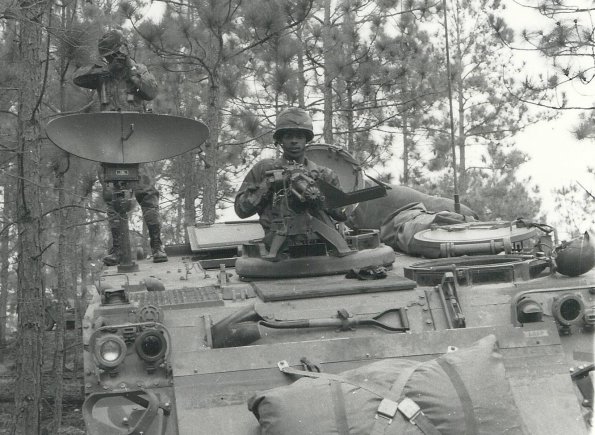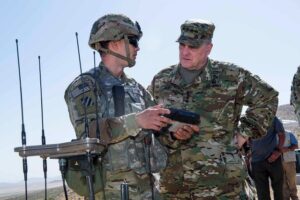Digital Stiletto: Army Pursues Precision Electronic Warfare
Posted on

An Army cyber/EW soldier sets up an antenna during exercises at the National Training Center, Fort Irwin.
WASHINGTON: After decades of neglect, the Army is urgently rebuilding its electronic warfare arm in a radically different form from the Cold War. The US isn’t trying to replicate the high-powered Russia arsenal that has scrambled GPS, radar, and radio from Scandinavia and Ukraine to Syria and Israel. Instead, the Army intends to combine EW with cyber, signals intelligence, and artificial intelligence to counter Russian power with a new kind of precision.
“When the Russians emit like that, they’re letting the entire world known where they are,” Col. Mark Dotson, the Army’s capabilities manager for EW, told reporters in June. That makes the Russian transmitters easier targets for the new long-range precision missiles that the US is developing.

Russian Krasukha-2 electronic warfare system with dish deployed. The system was reportedly used in Syria.
By contrast, Dotson continued, “we’re looking for much more discrete ways of conducting electronic attack, using low power to affect the signal — and to affect it in such a way it may not even be detectable that you’re interfering.”
Dotson told me in a follow-up interview that the Army has fielded fairly small numbers of several systems. The names are an alphabet soup of acronyms: TEWS, TEWL, TSIG, and the future TLIS, which will be mass-produced and is scheduled to enter service around 2022-2023.
[Click here to read Part II of this story, Digital Arsenal: Army Inches Forward On Electronic Warfare]
With each step, the Army comes closer to the combination it sees as critical for future conflicts with major powers like Russia and China. On that high-tech battlefield, the Army believes, cyberspace, the electromagnetic spectrum, and satellites in orbit will be as important as the traditional domains of land, air, and sea — a concept called Multi-Domain Operations.
“The goal is really the integrated signal intelligence, electronic warfare, and cyber operations capability to fight multi-domain operations in the future,” Dotson told me in a follow-up interview. “What happens in the spectrum now is a lot different than what happened in the spectrum in the ’90s.”

The Army disbanded its Combat Electronic Warfare Intelligence (CEWI) units, like the one shown here, after the Cold War.
The New Precision EW
How will the new digital battlefield be different? “We’re talking about subtle attacks, we’re talking about cyber operations, we’re talking about refined signals intelligence,” Dotson told me, “things that we can do now that we couldn’t do back then.”
Traditionally, signals intelligence and electronic warfare have often been at odds. Both need to detect and understand foreign transmissions, so their skill sets and equipment overlap, but SIGINT wants to listen in on enemy communications, while EW wants to shut them down.
Precision EW, however, raises the possibility of eavesdropping on the enemy network even as you disrupt it. Instead of old-school jamming that just drowns an enemy transmission in noise, making it unintelligible to friend and foe alike, you can interfere more subtly, using signals carefully tailored to deceive an enemy system or even download a virus onto it. You might disrupt a drone’s control link so it crashes, for example; or spoof a navigation signal so precision-guided missiles miss and ground troops get lost; or trick radar into seeing ghosts instead of your real planes — and all the time you’re listening to their communications to see how they react.
Best of all, these subtler effects aren’t immediately obvious to the enemy. Even when the target realizes something’s wrong, they may think it’s just a glitch in their system, an internal malfunction rather external interference.

The Army Chief of Staff, Gen. Mark Milley, checks out a cyber/electronic warfare unit at the National Training Center.
To use these new capabilities to the fullest, Dotson cautioned, “it will require more commander involvement.” In other words, Army commanders can’t delegate the electronic battle to their uniformed geek squad and forget it while they focus on guns and grunts. They and their staffs must learn to integrate electronic and cyber warfare into their battle plans alongside physical firepower and maneuver.
Sometimes the best way to neutralize an enemy might be to jam or hack them. Sometimes it might be to blow them up. Sometimes it might be a mix: for example, feint with your attack helicopters so the enemy anti-aircraft batteries turn on their radars and start talking to each other on radio, which you then jam.
“The commander really has a much wider range of options,” Dotson said. “It’s going to be a discussion, [and] initially, it’s not going to be a super clean process.” That will require a well-trained staff, he said, with specialists in different disciplines working closely together. For a start, Army headquarters at brigade level and above will now have a cyber/electronic warfare section.
But humans are not enough. The Army will probably need artificial intelligence as well. Modern radio-frequency transmitters — including EW jamming and spoofing tools as well as communication systems — are controlled by software that can change the frequency, wavelength, and other characteristics of their emissions in a matter of seconds. The radio waves themselves, of course, move at the speed of light. That’s radically faster than any physical weapon and a tremendous challenge for unaided human brains to keep up with.
“Even hypersonic weapons move incredibly slowly versus the electromagnetic spectrum,” Bill Conley, deputy director for electronic warfare under Pentagon R&D chief Mike Griffin, said at a conference this summer. “We have dramatically different schemes of maneuver and therefore dramatically different styles of C2 [command and control]. There will absolutely be automated decision-making.”
Now, how does the Army intend to actually build all this new tech? That’s the topic we’ll explore in the second part of this story, out tomorrow: Digital Arsenal: Army Inches Forward On Electronic Warfare
Subscribe to our newsletter
Promotions, new products and sales. Directly to your inbox.
